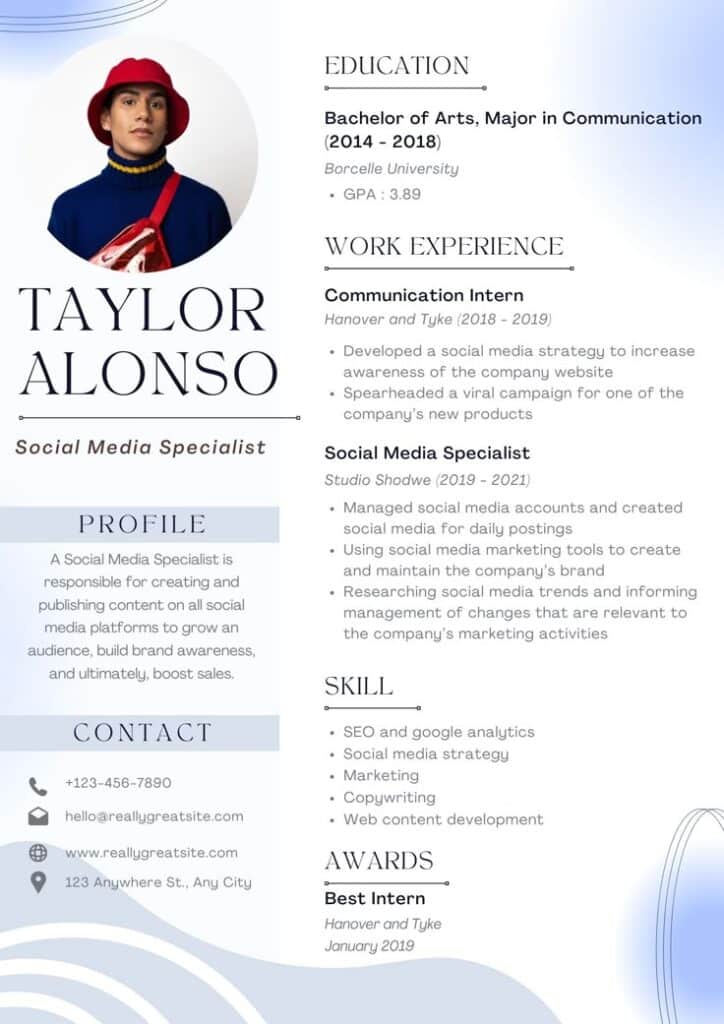A well-designed resume can set you apart in a competitive job market. The key to effective resume design is balancing clarity, professionalism, and a clean layout that highlights your skills and experience without overwhelming the reader. Your resume should communicate your value immediately and make it easy for hiring managers to find what matters most.
Choosing the right design isn’t about flashy graphics but selecting a format that supports the content and fits the job you want. Effective typography, spacing, and simple design elements guide the reader’s eye and improve the overall impression your resume makes.
You can create a strong resume by customizing templates that maintain professionalism while reflecting your unique background. Paying attention to structure and readability ensures your resume works for you, leading to more interview opportunities.
Key Takeways
- Use a clear and professional layout to enhance readability.
- Select a design that supports your qualifications and job goals.
- Prioritize simplicity and structure over decorative elements.


Core Principles of Effective Resume Design
Your resume must guide the reader’s eye efficiently, balance text and empty space to avoid clutter, and organize information clearly. These elements work together to make your resume both visually pleasing and easy to navigate.
Visual Hierarchy and Readability
Visual hierarchy directs attention to the most important parts of your resume. Use font size, weight, and style strategically—your name and section headers should stand out, while details remain subtle but legible.
Bold or italics can emphasize key points, but avoid overuse as it creates noise. Keep font choices clean and professional, typically sans-serif or serif fonts sized between 10-12 points for body text.
Line spacing and paragraph breaks also enhance readability. Avoid large blocks of text by breaking information into short, clear sections. This makes it easier for someone scanning quickly to locate essential details.
White Space and Layout
White space prevents your resume from feeling crowded and improves comprehension. Margins, spacing between sections, and gaps around text allow the content to breathe.
Do not cram the page with text. Instead, use white space deliberately to highlight each section clearly. This reduces visual fatigue and helps your resume appear organized.
Consistent alignment and balanced spacing create a clean layout. A cluttered resume can cause important details to be overlooked or misunderstood.
Use of Columns for Clarity
Using columns helps separate different types of information without mixing them in one block of text. For example, you can place contact information and skills in one column and experience details in another.
Columns improve scanning by grouping related items together. This structure supports a neat, visually pleasing format and maximizes space without overwhelming the reader.
Keep column widths even, or proportionate to content importance. Avoid adding too many columns; two or three at most maintain clarity without complicating the layout.


Selecting the Right Resume Template
Choosing the right resume template means balancing clarity, professionalism, and your industry’s expectations. Your choice will influence how easily hiring managers find your key skills and experience. Focus on templates that best highlight your strengths while aligning with the role you want.
Simple Resume Templates
Simple resume templates prioritize clean design and easy readability. These templates typically use basic fonts, clear headings, and minimal graphics. They work well in traditional industries like finance, education, and administration, where content clarity is critical.
A simple template ensures that your work history and skills stand out without distractions. You should look for templates that organize information logically, usually in a reverse-chronological format. Many free resume templates available online or through resume builders stick to this straightforward design.
Professional Resume Template
Professional resume templates emphasize structure and polish, aiming to make a strong impression without seeming flashy. They use balanced white space, consistent fonts, and subtle design elements that guide the reader’s eye.
You may want to choose a professional template if you’re applying for corporate or technical roles. These templates often include sections for a summary, key skills, and detailed experience. They help highlight your qualifications while maintaining a formal tone.
Many resume builders offer professional templates tailored to different fields. These templates are ideal when you want your resume to look refined and organized.
Creative Resume Template
Creative resume templates incorporate design elements like color, icons, or unconventional layouts. They suit industries where personality and design skill matter, such as marketing, graphic design, or media.
When using a creative template, focus on balancing creativity with readability. Overly complex designs can make it difficult to scan your resume quickly. Use color and graphics to emphasize key points rather than clutter.
Choose a creative template only if the job posting encourages innovation. Otherwise, simple or professional formats remain safer.
Using Free Resume Templates
Free resume templates provide accessible options for formatting your resume without cost. Many reliable sources offer templates compatible with common software like Word, Google Docs, or online resume builders.
When selecting a free template, check for clear section organization and a modern look. Avoid outdated styles that might harm your first impression.
You can customize free templates through a resume builder to add personal touches while maintaining good design principles. This approach saves time and helps you submit a professional-looking resume quickly.


Optimizing Resume Content for Employers
To make your resume effective, focus on clearly presenting your professional background and skills. Emphasize measurable results and use concise formatting to help potential employers quickly understand your value.
Showcasing Experience and Work History
List your work history in reverse chronological order, starting with your most recent job. Include your job title, company name, location, and dates of employment for each role.
Describe your responsibilities in clear, specific terms. Avoid vague statements; instead, focus on duties that directly relate to the job you want. This helps employers quickly see your relevant experience.
For each position, tailor your descriptions to match the skills and experience the employer is seeking. This alignment increases your chances of passing initial screenings and catching employer attention.


Highlighting Achievements and Key Skills
Quantify your achievements with numbers, percentages, or other data points where possible. For example, “increased sales by 20%” or “managed a team of 10.” Specific results demonstrate your impact more clearly than generic statements.
Separate key skills into a dedicated section. Use a mix of hard and soft skills relevant to the job. Employers often scan for keywords here, so include skills mentioned in the job description.
Focus on skills that show your ability to perform tasks or solve problems. This makes your resume more attractive to recruiters and automated screening systems alike.
Utilizing Action Verbs and Bullet Points
Start each bullet point with a strong action verb such as “implemented,” “led,” or “designed.” Action verbs create a dynamic and clear picture of your contributions and skills.
Use bullet points to break up information and improve readability. Keep bullets short and focused—one to two lines each—making it easier for employers to scan your resume quickly.
Avoid paragraphs or long sentences in these sections. Clear, concise bullet points highlight your achievements and responsibilities efficiently, which is important to busy hiring managers and ATS software.


Typography and Formatting Choices
Your choice of fonts, how you use emphasis, and the application of italicized text all play a crucial role in making your resume clear and professional. Each element affects readability and the way recruiters perceive your information.
Font Selection for Maximum Impact
Choose fonts that are professional, legible, and widely accepted. Fonts like Arial, Cambria, Garamond, and Times New Roman are safe options for resumes. Sans-serif fonts such as Arial or Calibri offer a modern, clean appearance, which improves readability on screens.
Limit your resume to one or two font styles to keep a consistent look. Avoid decorative or overly stylized fonts because they can distract from your content. Stick with standard font sizes between 10 and 12 points for body text to ensure your resume is easy to scan.
Strategic Use of Emphasis
Use emphasis sparingly to guide the reader’s eye to key points. Bold text works well for section headings, job titles, and company names. This helps clarify the structure of your resume and highlights your roles effectively.
Avoid excessive bolding or underlining, as it can reduce impact and clutter your layout. Reserve bold for important information and consider using capitalization consistently to add subtle emphasis without overdoing it.
Incorporating Italicized Text
Italicized text can be useful to indicate additional details like project names, certifications, or foreign titles. Apply italics mainly to secondary information that should stand out but not compete with main content.
Do not italicize large blocks of text, as this reduces readability. Use italics to differentiate specific items neatly. For example, italicizing publication titles or software names can help organize your data visually without distracting the reader.


Incorporating Graphic and Design Elements
Effective use of design elements can make your resume stand out and communicate professionalism. However, these additions must enhance readability and clarity without distracting from your qualifications.
Adding Graphic Elements Thoughtfully
When adding graphic elements to your resume, choose simple visuals that support your content. Use icons or small charts to illustrate skills or achievements, but avoid overcrowding the page.
Stick to a cohesive color scheme—preferably two to three colors—that matches your industry and personal brand.
Prioritize legibility; for example, use clean lines and clear typography. Avoid heavy backgrounds or complex patterns that can make your text difficult to read.
Ensure that any graphics you add are relevant. For instance, a visual timeline can clarify your work history better than a lengthy paragraph. This targeted use of graphics strengthens your message without overwhelming it.
Balancing Visual Design with Content
Your resume’s design must not overshadow the information it presents. Hiring managers focus on experience and skills, so prioritize clear, organized content.
Maintain plenty of white space to prevent clutter. Structured sections with consistent alignment help guide the reader’s eye through your resume logically.
Use visual hierarchy—such as bold headers and varied font sizes—to highlight important details without excessive decoration.
Remember, a great resume is both attractive and functional. Your design should support the content, not compete with it. Always review the resume from a recruiter’s perspective to ensure clarity and professionalism remain front and center.
- 1.0Kshares
- Facebook0
- Pinterest1.0K
- Twitter0



